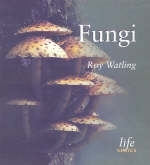
Fungi
Seiten
2003
The Natural History Museum (Verlag)
978-0-565-09182-8 (ISBN)
The Natural History Museum (Verlag)
978-0-565-09182-8 (ISBN)
- Titel ist leider vergriffen;
keine Neuauflage - Artikel merken
Desgined as a resource for botanists and those interested in fungi, and suitable as background reading for the general reader or student, this illustrated text focuses on the larger fungi; those which have an obvious fruiting body.
Designed as a resource for botanists and all those interested in fungi, and suitable for the general reader or student looking for background reading, the focus of this text is the larger fungi; those which have an obvious fruiting body. Roy Watling MBE, a respected mycologist who has written widely on the subject of fungi, sheds light on these intriguing organisms in a clear, accessible text illustrated with colour photographs on every page. In a world without fungi, all the fallen trees, dead leaves, animal remains and other detritus would accumulate until the surface of the planet resembled a vast refuse tip, with little room for living things to exist. The job of breaking down organic materials and recycling the component molecules back into the environment is just one of the essential roles of fungi. Once regarded as simple plants, they are now thought of as a separate kingdom, having diverted from common ancestors up to 500 million years ago.
Whether growing by the side of a forest path or served on toast, the classic "mushroom" fruiting bodies are only the most visible signs of some of the large fungi, which may exist for all or most of the time as long, hidden filaments known as hyphae, Trees, some of the world's largest plants, depend on fungi for help in obtaining mutrition from the soil. Fungi are present in almost every habitat on earth, and single specimens can occupy several hectares of land. They occupy a key place at the base of the food chain and are of great economic and biological importance, but it is only recently that scientists have begun to realize the ecological significance of fungi. The chapter on conservation gives an idea of just how vital it is to study and protect the habitats in which they thrive.
Designed as a resource for botanists and all those interested in fungi, and suitable for the general reader or student looking for background reading, the focus of this text is the larger fungi; those which have an obvious fruiting body. Roy Watling MBE, a respected mycologist who has written widely on the subject of fungi, sheds light on these intriguing organisms in a clear, accessible text illustrated with colour photographs on every page. In a world without fungi, all the fallen trees, dead leaves, animal remains and other detritus would accumulate until the surface of the planet resembled a vast refuse tip, with little room for living things to exist. The job of breaking down organic materials and recycling the component molecules back into the environment is just one of the essential roles of fungi. Once regarded as simple plants, they are now thought of as a separate kingdom, having diverted from common ancestors up to 500 million years ago.
Whether growing by the side of a forest path or served on toast, the classic "mushroom" fruiting bodies are only the most visible signs of some of the large fungi, which may exist for all or most of the time as long, hidden filaments known as hyphae, Trees, some of the world's largest plants, depend on fungi for help in obtaining mutrition from the soil. Fungi are present in almost every habitat on earth, and single specimens can occupy several hectares of land. They occupy a key place at the base of the food chain and are of great economic and biological importance, but it is only recently that scientists have begun to realize the ecological significance of fungi. The chapter on conservation gives an idea of just how vital it is to study and protect the habitats in which they thrive.
How important are fungi?; what is a fungus?; the larger fungi; when and where?; collecting and studying fungi; fungi and humans; conservation; further information.
| Erscheint lt. Verlag | 1.11.2003 |
|---|---|
| Reihe/Serie | LIFE |
| Verlagsort | London |
| Sprache | englisch |
| Gewicht | 350 g |
| Themenwelt | Sachbuch/Ratgeber ► Natur / Technik ► Natur / Ökologie |
| Kinder- / Jugendbuch ► Sachbücher ► Naturwissenschaft / Technik | |
| Kinder- / Jugendbuch ► Sachbücher ► Tiere / Pflanzen / Natur | |
| Naturwissenschaften ► Biologie ► Mykologie | |
| ISBN-10 | 0-565-09182-4 / 0565091824 |
| ISBN-13 | 978-0-565-09182-8 / 9780565091828 |
| Zustand | Neuware |
| Haben Sie eine Frage zum Produkt? |
Mehr entdecken
aus dem Bereich
aus dem Bereich
über 500 faszinierende Gesteine, Minerale, Edelsteine und Fossilien
Buch | Hardcover (2023)
DK Verlag Dorling Kindersley
CHF 39,90
Familien und Gattungen einheimischer Pflanzen
Buch | Hardcover (2022)
Haupt Verlag
CHF 67,95
Klimaschutz zerstört die Wirtschaft! ... und andere Stammtischparolen …
Buch | Softcover (2024)
Komplett-Media (Verlag)
CHF 33,55


